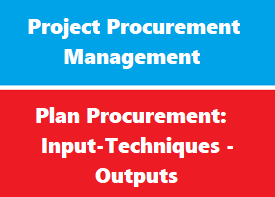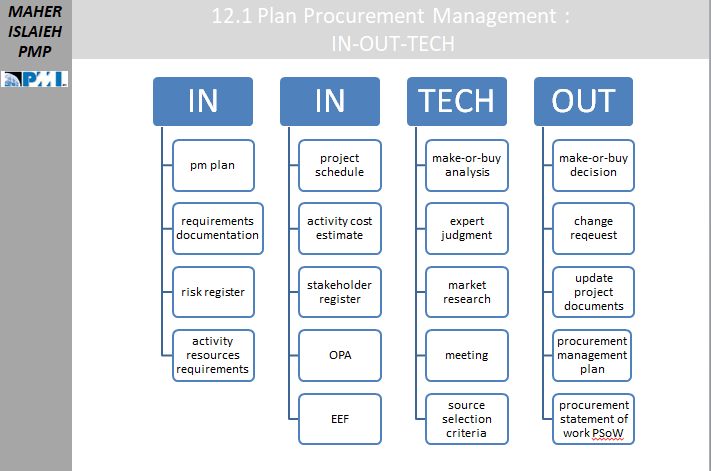intrduction
in previous article we have got the concepts of plan procurement
this article we will continue to discuss the plan procurement inputs – techniques – outputs
pleas join us
Process inputs - techniques - outputs
Inputs
- pm plan
- requirements documentation
- risk register
- activity resources requirements
- project schedule
- activity cost estimate
- stakeholder register
- OPA
- EEF
Techniques
- make-or-buy analysis
- expert judgment
- market research
- meeting
- Data Gathering
- Data Analysis
- Source Selection Analysis
Outputs
- procurement management plan
- procurement statement of work PSoW
- procurement documents
- source selection criteria
- make-or-buy decision
- change reqeuest
- update project documents
Process- inputs
Plan Procurement Management: Inputs
Project Charter
- Business case–this is usually created by the business analyst, and the main point in referring to this document is that the procurement strategy needs to be aligned to the strategy underlying the business case.
- Benefits management plan–this describes when the specific project benefits are expected to be available, which will drive the dates of the procurement as well as the language of the contract.
Project Management Plan
The components of the project management plan that may serve as inputs to this process are:
- Scope management plan–this will describe how the scope of work done by the contractors will be managed through the execution phase of the project.
- Quality management plan–this will describe any applicable industry standards as well as any other codes that the project is required to follow. These standards will be included in bidding documents such as the Request for Proposal (RFP), and may be used as part of the selection criteria for supplier prequalification.
- Resource management plan–this has information on which resources will be purchased or leased, along with any assumptions or constraints that would influence the procurement.\
- Scope baseline–the scope baseline actually consists of three separate documents: the scope statement (which breaks the scope down from the requirements to the level of deliverables), the Work Breakdown Structure or WBS (which breaks the scope down further from the level of deliverables to the level of work packages), and the WBS dictionary (which gives additional information on the work packages).
Project Documents
- Milestone list–this list of major milestones for the project will show when the sellers are required to deliver their results
- Project team assignments–this contains information on the skills and abilities of the project team and their availability to support the procurement activities.
- Requirements documentation–this may include:
- Technical requirements that the seller is required to satisfy
- Requirements with contractual and legal implications, such as health and safety regulations, licenses, permits, intellectual property rights, etc.
- Requirements traceability matrix–this lists the product requirements from their origin to the deliverables that satisfy them, as well as the “owners” of the requirements who can be consulted if there are questions concerning them.
- Risk register–some risks may be transferred to the seller via a procurement agreement.
- Stakeholder register–provides details on the project participants and their interests in the project, which for the sake of procurement will include the contracting personnel (those specializing in procurement within the organization doing the project) as well as legal personnel (who manage the agreements with sellers).
Enterprise Environmental Factors
- Marketplace conditions, as well as products, services and results available in the marketplace.
- Past performance of reputation of potential sellers
- Multi-tier supplier system of prequalified sellers based on prior experience
- Typical terms and conditions for products, services and results for the specific industry
- Unique local requirements, such as regulatory requirements for sellers (including local labor)
- Contract management systems, including procedures for contract change control)
- Legal advice regarding procurements
- Financial accounting and contract payments system
Organization Process Assets
- Preapproved seller lists–lists of sellers that have been properly vetted can streamline the steps needed for the seller selection process
- Formal procurement policies, procedures, and guidelines–most organizations have formal procurement policies and buying organizations. In fact, all aspects of procurement may be handled not by the project manager, but by a designated procurement manager for the organization. If this is not the case, then the project team will have to supply both the resources and the expertise to perform such procurement activities.
- Contract types–all legal contractual relationships generally fall into two broad families: either fixed-price contracts where the cost risk falls on the seller, or cost-reimbursable contracts where the cost risk falls on the buyer.
- These contract types can be modified by incentive fees, economic price adjustments, and/or award fees in order to balance the risk between the parties. There is a third type of contract called the time and materials contract, which is considered a hybrid type or contract, as the risk is shared by both the seller and the buyer.
Process - techniques
Plan Procurement Management: Tools & Techniques
Expert Judgment
As a project manager, you will help from experts who have expertise in the following areas in order to draft your Procurement Management Plan.
- Procurement and purchasing
- Contract types and contract documents
- Regulations and compliance issues
Data Gathering
Market research is a data-gathering technique often used to help create the Project Management Plan. Market research includes the following examination of industry and specific seller capabilities. The objectives of market research are to:
- Leverage maturing technologies
- Balance risks associated with the sellers who can provide the desired materials or services, particularly with risks to various project constraints such as cost, schedule, and quality.
Data Analysis
Make-or-buy analysis is used to determine whether the deliverables of a project (which are found in the project scope statement) can best be accomplished by the project team or should be purchased from outside sources. The factors to be considered are:
- the organization’s current resource allocation, as well as their skills and abilities
- the need for specialized expertise
- the desire not to expand permanent employment obligations
- the need for independent expertise
- the risks involved with the make-or-buy decision
The make-or-buy analysis make use financial tools and techniques, including the same ones used to analyze the viability of the project itself, such as
- Return on investment (ROI)
- Internal rate of return (IRR)
- Discounted cash flow
- Net present value (NPV)
- Benefit/cost analysis (BCA)
Source Selection Analysis
Commonly used selection methods include the following:
- Least cost–appropriate for procurements of a standard or routine nature which have well-established practices and standards and from which a specific and well-defined outcome is expected.
- Qualifications only–if the value of the procurement is relatively small, a full selection process may not make sense. The buyer establishes a short list and selects the bidder with the best credibility and qualifications.
- Quality-based/highest technical proposal score. For products and/or services that involve technology, the sellers are encouraged to submit a proposal with both technical and cost details. The seller who submitted the highest-ranked technical proposal is selected if their financial proposal can be negotiated and accepted.
- Quality and cost-based. If the risk and/or uncertainty are greater for the project, quality should be a key element when compared to cost. The previous method of “quality-based and highest technical proposal score” is similar, but for products and services that involve technology.
- Sole source–if there is no competition, this method is acceptable ONLY when properly justified and viewed as an exception. It is either for sole providers of a product or service, but for trusted providers with a history of past projects with the company.
- Fixed budget–when the statement of work (SOW) is well-defined, no changes are anticipated, and the budget is fixed and cannot be exceeded, this method may be appropriate. The available budget is disclosed to invited sellers in the Request for Proposal (RFP) and the highest-ranking technical proposal given in response to that RFP is then selected.
Meetings
- Meetings are used to determine the strategy for managing and monitoring the procurement,
Process - outputs
Plan Procurement Management: Outputs
The only output procurement management plan contains the activities to be undertaken in the procurement process :
Integration Management
- Constraints and assumptions that could affect planned procurements.
Schedule Management
- How procurement will be coordinated with project schedule development.
- Timetable of key procurement activities.
Cost Management
- The legal jurisdiction and currency in which payments will be made.
- Determination of whether independent estimates will be used and whether they are needed as evaluation criteria.
Risk Management
- Identifying requirements for performance bonds or insurance contracts to mitigate some forms of project risk (for example, cost risk).
Procurement Management
- Metrics used to manage procurement contracts.
- If the performing organization has a procurement department, the authority levels and other constraints of the project team.
- Prequalified sellers, if any, to be used.
Stakeholder Management
- Stakeholder roles and responsibilities related to procurement.


